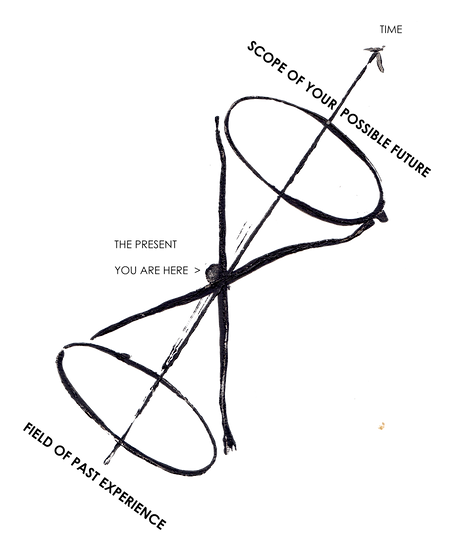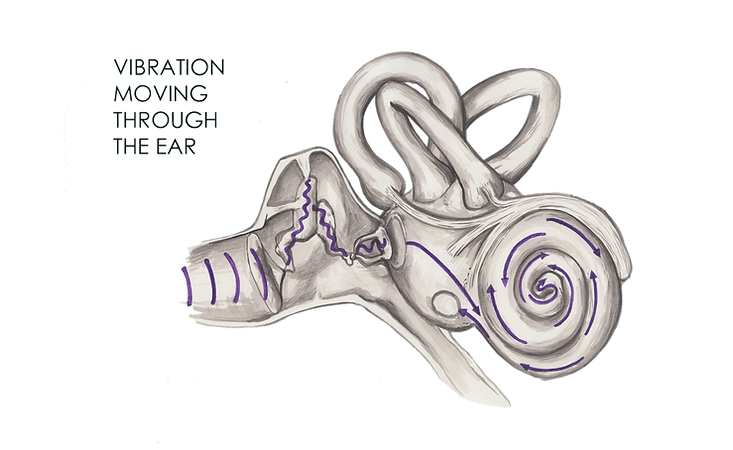


Brainspotting (BSP) uses eye positioning and the awareness of sensation, to integrate past trauma and adversity without having to use explicit language or conscious memory retrieval.
BRAINSPOTTING


"WHERE WE LOOK EFFECTS HOW WE FEEL"
- BSP developer David Grand
The Theory
The eyes play a vital role in information storage and retrieval. Our brains have evolved over millennia to uses spots in the visual field to assist in memory recall. For example, during a conversation you might notice someone break eye contact when they are thinking, or you might be aware you eyes go to certain place while you trying to remember a specific fact.
.png)
This automatic association between particular thoughts/concepts/feelings and eye position is less surprising when we consider that the retina originate as an outgrowth of the developing brain in utero. Comprised of neurons, they are also classified as part of the Central Nervous System, meaning work done through the visual field helps us to work with deeper regions of the brain where trauma imprinting occurs.
This unfurling takes place at a subcortical level (bellow consciousness) and is profound and often surprising. I rarely get through a session without my clients exclaiming “how strange” or “thats weird”, as a seemingly unrelated memory emerges or bodily sensation gets vividly triggered. This makes the work deeply insightful as it bypasses assumptions and blindspots we might have about ourselves.
By focusing on an emotional symptom, such as anxiety, and tuning into where that is in the body, we can find visual positions that intensify or lessen feelings around the issue. By using a pointer to mark these spots and fixing our gaze on them, we can openly investigate the unresolved past conflicts that contribute to the issue. By simply placing our awareness on physical sensations our embodied history will start to reveal itself, we simply have to let our attention follow as it unfurls.
I run workshops that teach more about the science behind our systems, click here to find out more about whats coming up

Brainspotting is a simultaneous form of diagnosis and treatment.
Given that human brains have 1-4 quadrillion synaptic connections, trying to predict which experiences influence our current issues, is a pointless task. In BSP, we work from whatever is troubling the client at the time and trust the bodies natural ability to lead us to where it needs to go in order to resolve it.
Along side healing impactful events (ptsd, accidents and injury), it works to repair early childhood wounding and hidden internal conflict stemming from negative emotional experiences that once overwhelmed our system. It can also be used for performance optimisation across a huge range of activities from creative practice and competitive sports, to career and work-life
The Practice
Sessions are typically 90 mins though the work continues to integrate over the next couple of days. Clients often report increased insights during this period or resolve in areas of their lives they hadn’t thought associated. The practices is commonly also used for performance enhancement and I personally work with many artists, musicians and dancers who’s body is their main tool, helping them take out limits in their craft and creativity.
I have a back ground in competitive sport at national level and work with those suffering from sporting injury or needing assistance to move their bodies forward in completion. Having been a lifeguard in my youth I also understand the impact of vicarious trauma which is often a predominately visual experience and find BSP to be an incredible tool for helping find ease and shift this form of PTSD.
BSP developed off EDMR when David Grand was experimenting with a client and found it to be just as effective to keep a pointer still in a clients field of vision as it was to move it from side to side. It also pulls online on both the left and right brain hemispheres but this is done by an audio track that pans between the ears. While studies show its as effective in trauma healing, many clients find BSP to be a softer approach and the subtle techniques within it can tune the direction and intensity so even deep release work can be done within the clients comfort zone.
Contact me for a free 20 min consultation to find out what BSP could do for you

Interior window
The therapist moves the pointer and the client establishes the spot in the visual field at which the clients feel the most activation.
Gaze Spotting
We can also work off the natural place a clients eyes rest while thinking on an issue. This is also a way of using it as a self help tool, which I train interested clients in.
Exterior window
Therapist identifies the spot in the clients field of vision. This might be seen in a blink, a facial twitch, pupil dilation, breath or a slight movement when the point passes the appropriate spot.
Establishing Brainspots:
We can do this in three main ways;
'Duel Attunement' refers to is the focused connection between client and practitioner.
Being energetically held while re-accessing tough events is a corrective experience that allows the client to integrates the past and create new neurological pathways. Any sense of threat trapped in the system can be let go of, allowing new personal qualities to come through.

Binaural soundtrack
The science behind BSP acknowledges the differing roles of our left and right brain hemispheres. This proposes that while in contemporary society our left brain now rules over our right, this is a reversal of how our systems have evolved and are actually meant to run. While the neocortex of the right brain processes information from the sub-cortex via experience, the role of the left side of the neocortex is to map or categories that information schematically.
Our history is in the subcortext and the tissues of the body. While we often come into therapy with our left brains ‘chat and patter’, its the right brain we need to access if we want to retrieve and work with how the experiential has been embedded in our system (like in the case of trauma).

Binaural tracks assist in this by rhythmically splitting sound across the left and right channels. There are many out there, that adapt existing music and while these do the trick for a lot of people they can often trigger or draw on distinct emotions or memory. Some people enjoy how that directs their process, but many of my clients find it distracting and a bit leading when they are already getting into something.
This one is designed to loops without a distinct break and is non- evocative.
While it is best played off headphones directly into the ears, stereo speakers either side of the room, to the left and right of where you are sitting, will also work. It can be played bellow audibility as its essentially the vibrations doing the work of keeping both brain hemispheres on line.
Though designed for use with Brainspotting its also great for any concentrated work or meditation practice.
Other more evocative tracks can be found here;